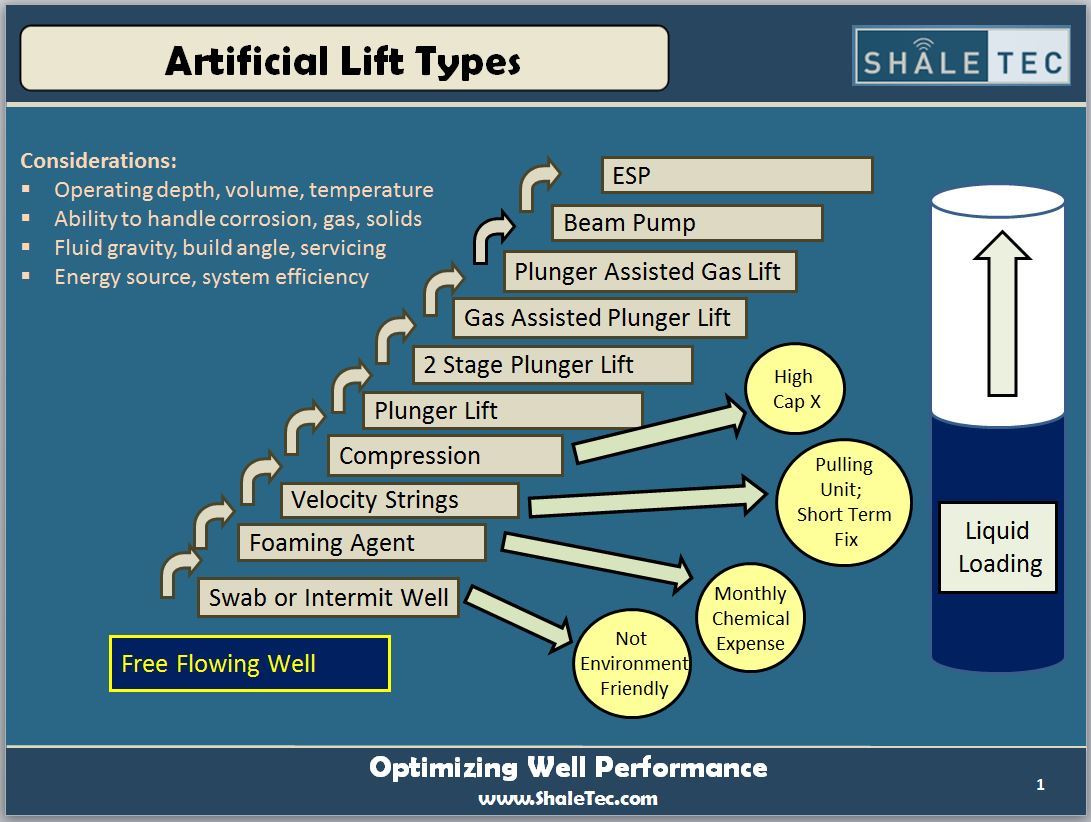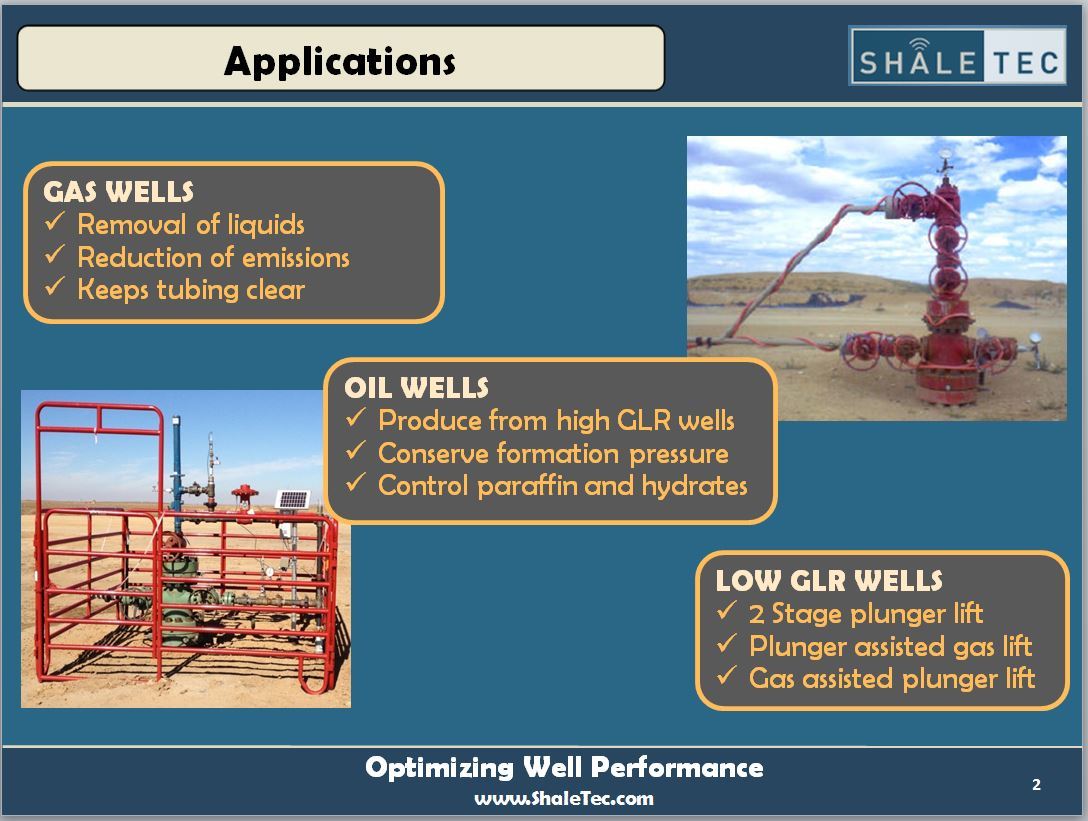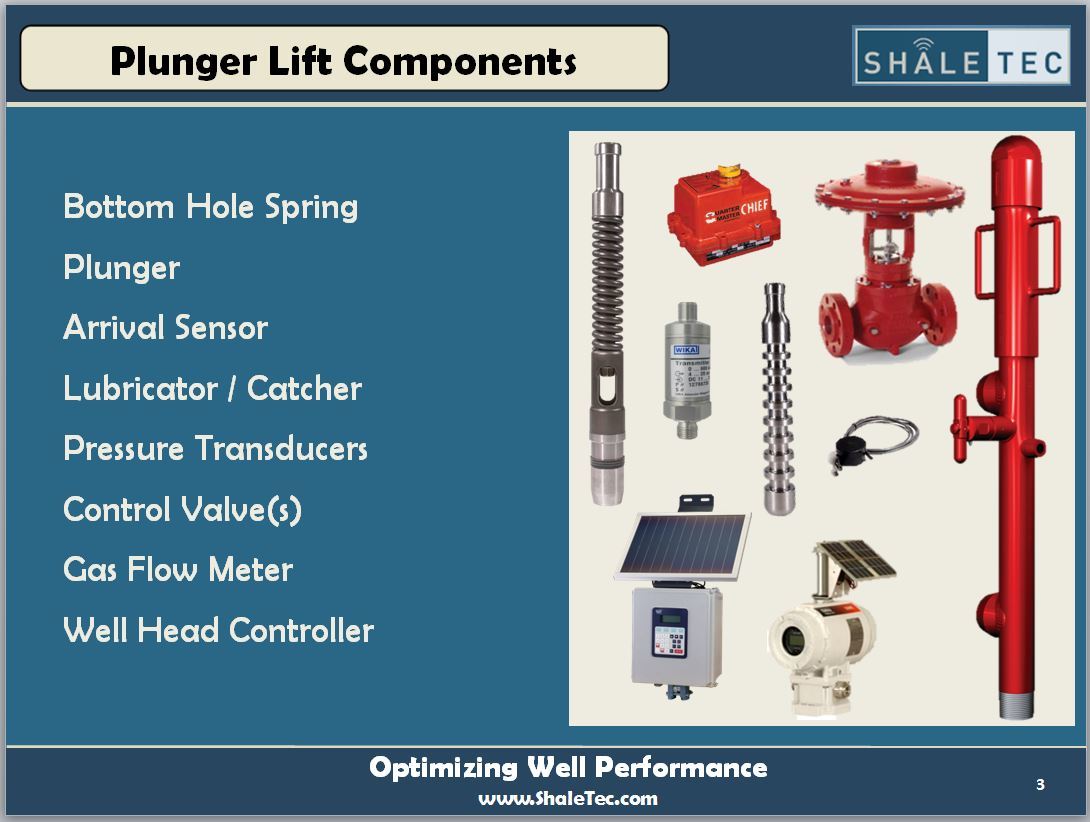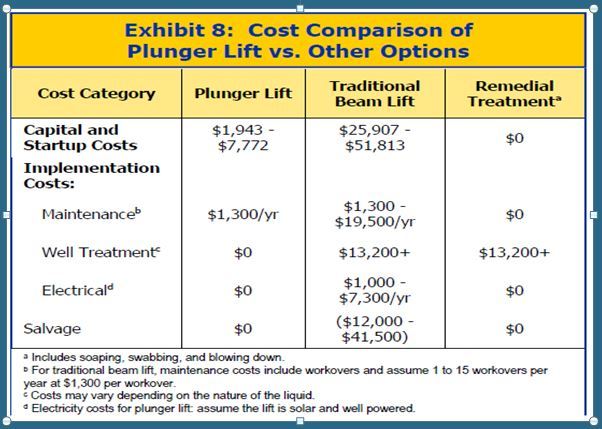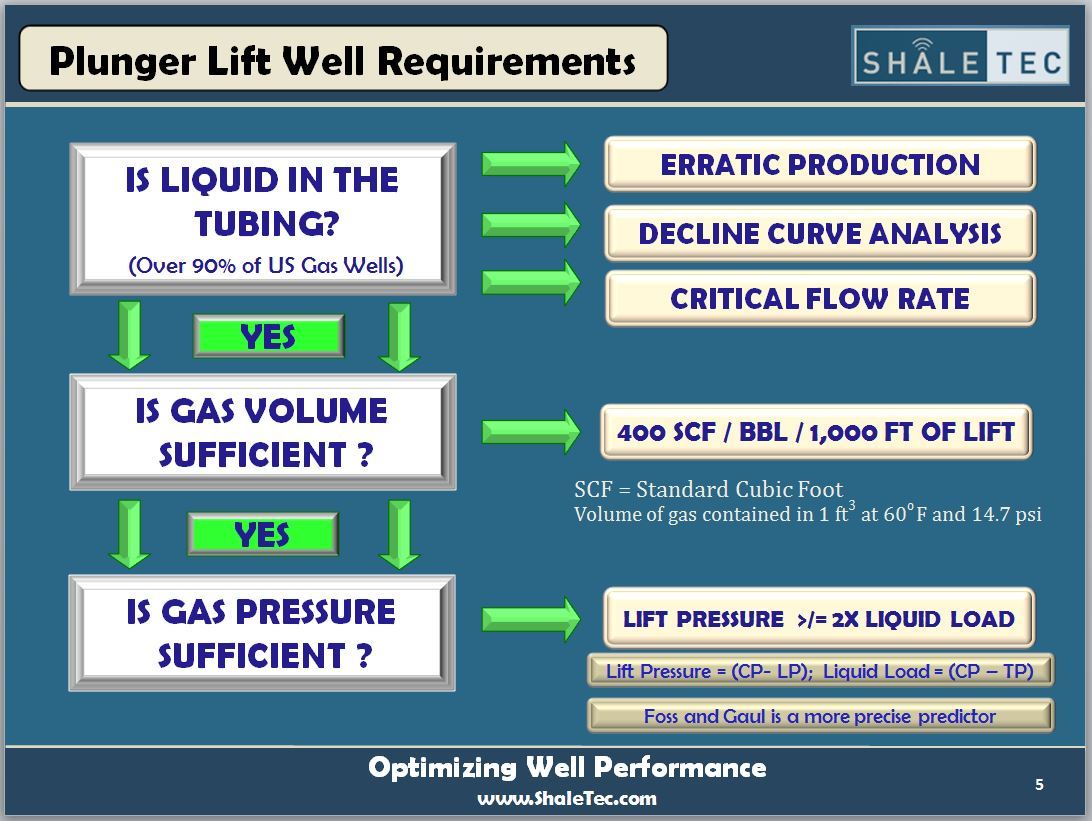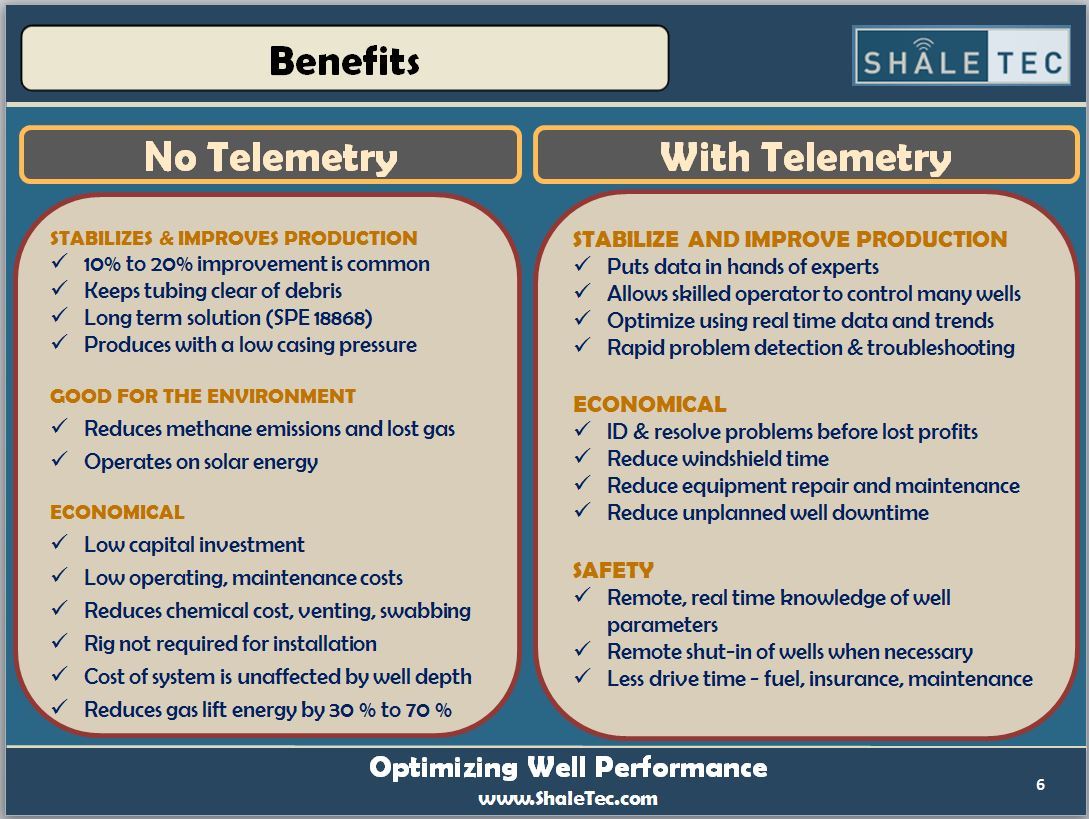Why Plunger Lift? (Dec 8, 2015)
Studies suggest 90% of the gas wells in the United States will at some point collect water in the well bore, thus impeding the rise of gas to the surface. For these wells, some form of artificial lift is required to remove the liquid so that gas may flow freely to the surface. In addition to blocking the well bore, liquid creates backpressure on the reservoir, thus restricting natural gas in the reservoir from entering the well. By removing the liquid, backpressure is reduced and more gas flows into the well.
Swabbing, intermitting wells, foaming agents and gas lift are common technologies competing with plunger lift. Swabbing consists of a special truck which lowers a cable into the well. Swab cups attached to the cable lift liquid as the cable is retrieved from the well. Intermitting wells consists of closing the well for a period of time to allow sufficient pressure to build, then opening the well. The increased pressure pushes the liquid in the well to the surface. Yet, the well eventually again loads with liquid and dies. Foaming agents transform the liquid in the well into a foamy consistency, thus making it easier for gas to rise through the foam. Foaming agents are either periodically injected into the annulus at the surface or dropped into the tubing in the form of a soap stick. Finally, gas lift consists of installing gas lift valves at the appropriate spacing on the tubing string. High pressure gas is injected into the well’s annulus, causing the gas lift valves to open, thus allowing gas to pass from the annulus into the tubing. As each valve sequentially opens (top valve first), the injected gas pushes the liquid in the tubing above the open valve to the surface. Once the liquid above the top valve clears the surface, the valve closes and the next deeper valve opens. The process repeats until only the deepest gas lift valve is open.
Plunger lift is an efficient, low cost method to remove liquid from wells. It is primary used in gas wells with sufficient gas volume and pressure to push the plunger and liquid column to the surface. Where insufficient gas volume or pressure exists, alternate forms of plunger lift should be considered. And, as many are experiencing, plunger lift can successfully lift oil in wells which also produce some volume of associated gas. Where the oil itself is still under pressure, less gas volume than the typical rule of thumb (400 scf per barrel per 1,000 feet of lift) may be required.
The basic components of a plunger lift system consist of a lubricator attached to the well head, a bottom hole spring located in the tubing string, a plunger, an arrival sensor and a controller. Additional equipment includes an electronic flow meter, pressure transducers and a control valve. The controller sends a signal to the control valve at the appropriate time to open and close the well.
Conventional plunger lift systems have 4 distinct stages – Plunger Fall, Pressure Build, Plunger Rise and Production Mode (or afterflow). When the well is closed, gas ceases to flow to the surface and the plunger free falls to the bottom of the well. Pressure builds in the annulus during the plunger fall stage. During the pressure build stage, the plunger rests on the bottom hole spring as pressure continues to build in the annulus. When sufficient pressure is available, the well opens. Stored pressure in the annulus flows into the end of tubing and drives the plunger and column of liquid toward the surface (plunger rise). Once at the surface, the flow of gas holds the plunger in the lubricator. The production stage allows gas to flow into the pipeline, and additional liquid to enter the well. Closing the control valve ends the production stage, thus allowing the plunger to descend to the bottom hole spring. The cycle repeats. Optimizing production requires each plunger lift stage to be optimized!
Continuous flow plungers differ from conventional plungers in that they will fall while the well is flowing. It may be necessary to close the well for a brief period until the plunger falls out of the lubricator, then open the well allowing the plunger to descend to the bottom hole spring. Continuous run plungers are often considered for wells flowing above 350 mcf/d; and have increased production on wells flowing as high as 1.5 mmcf/d!
PCSFerguson has two educational videos on You Tube defining the typical plunger lift cycle for conventional and continuous cycle plungers:
The cost of plunger lift as compared to rod pumping units is detailed in a study published by the EPA in October 2006. Additionally, the Artificial Lift Research and Design Council (www.ALRDC.org) published “Guidelines & Recommended Practices: Use of Plunger Lift for Deliquifying Gas Wells”. In this document, the capital cost for a complete plunger lift system is identified as $ 15,000 to $ 25,000, with the operational expenses estimated at $ 2,000 per year. Total lifting cost ($/mcf produced) is exceptionally low for plunger lift as compared to other artificial lift means – thus making it an attractive choice for many oil and gas wells.
For a well to be a viable plunger lift candidate, a number of factors must be considered. The basic questions are:
- Is liquid in the tubing?
- Is gas volume sufficient?
- Is gas pressure sufficient?
- Is the tubing clear of obstructions and leak free?
- Is the tubing ID constant from the bottom hole spring to the flow outlets?
- Have all restrictions been identified and addressed?
- Will the flow line support production spikes when the well is open?
Questions 1-3 are a function of the well’s basic characteristics, and thus primary in determining the wells response to plunger lift. Questions 4 – 7 are mechanical in nature and may be resolvable prior to plunger lift installation. Gas wells meeting conditions 1-3 are generally good candidates for plunger lift. However, operators must carefully consider questions 4 through 7 for optimal well performance.
In addition to the preliminary methods shown above; a pressure survey, Echometer acoustical analysis or PCSFerguson Smart Plunger can be utilized to determine if and how much liquid is in the tubing.
The benefits of plunger lift generally fall into two categories – basic benefits without the assistance of remote surveillance and enhanced benefits realized with remote surveillance. Remote surveillance involves utilizing available technology to view the wells performance and make adjustments from a remote location. Individual plunger lift optimizer’s using remote surveillance often work with over 120 wells, realizing significant cost and performance benefits.
Historically, the industry publicizes 10 % to 20% increase in production is common with plunger lift. However, the % improvement is tied directly to actual production verses the natural decline curve. When production is 20% below the natural decline curve due to liquid loading, it’s likely plunger lift will return production back to the natural decline curve. While payback for the cost of the system may seem attractive with a 20% production increase, it’s far more profitable to install the proper artificial lift type BEFORE production is lost!
Plunger lift limitations include:
- Sufficient gas volume required
- Sufficient gas pressure required
- No holes in the tubing
- Restrictions identified and addressed
- Max daily liquid removal rate limitation
- increased gas volume required if a packer is in place
Yet, the knowledge of the plunger lift operator is the single greatest contributor to optimizing production from a plunger lifted wells!
ALRDC’s “Guidelines & Recommended Practices: Use of Plunger Lift for Deliquifying Gas Wells” addresses this issue as follows:
Section II. Operating Best Practices
- Train operators in liquid loading principles and plunger lift operation.
- Basic understand of gas well liquid loading
- Firm understanding of plunger lift
- Firm understand of controller operation
- Train and abide by safe operating principles
- Ensure knowledge of common terminology
In April 1998, Dan Phillips and Scott Listiak of Conoco Inc. published a two part article in World Oil titled “How to optimize production from plunger lift systems”.
The article states:
“It has been Conoco’s experience, with more than 200 plunger lift systems in the San Juan basin, that the plunger operator is the single most important factor in keeping a plunger system operating efficiently. If an operator knows certain principles of plunger operation and gas well mechanics, he can effectively maintain and trouble-shoot the system. His goal will be to optimize the system, keep a good maintenance schedule and attempt to flow the well against the lowest pressure possible. …. An operator who does not understand basic principles may try to “just keep the plunger running”, and he may be frustrated when the system does not work well”.
Plunger lift is an underutilized, cost effective, efficient artificial lift means to improve production on underperforming gas and oil wells. Some operators have achieved in excess of 50% production improvement by adding or optimizing plunger lift – and significant increases across entire fields.
If your team could benefit from a greater understand of plunger lift, consider attending one of Shale Tec’s 2-Day Plunger Lift Training Courses in 2016!
Or, contact Shale Tec at [email protected] to schedule an in-house training course specifically for your team.
And, join the Linkedin Group “Plunger Lifted Gas Wells” to discuss plunger lift issues with other operators and manufacturers.
The above article was written by David Cosby P.E. of Shale Tec LLC
Copyrighted December 2015
